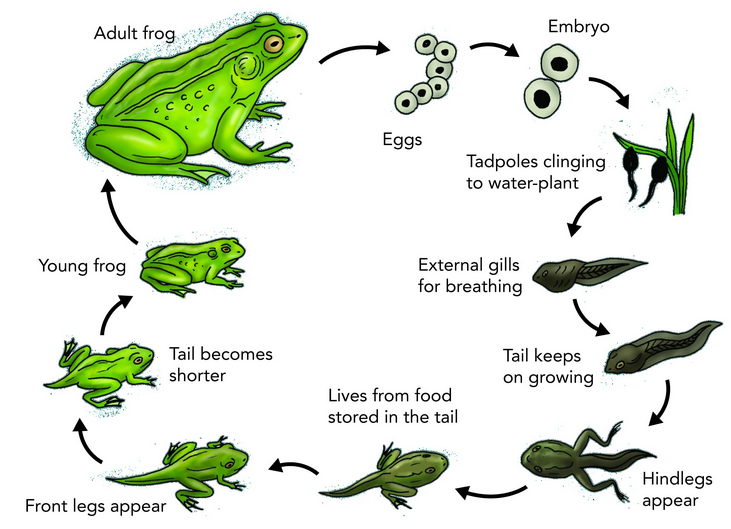
Metamorphosis in Frog
Embryonic Development of Class 12
Metamorphosis in Frog
To compensate the deficiency of yolk in egg the development is indirect passing through intermediate free living stage i.e. tadpole larva.
Precocious 6 mm long tadpole hatches out after about 116 hours of fertilization.
Features of tadpole
Oral-sucker Stage:
One pair of oral suckers on ventral side of head are the only distinct part which help larva attach to any object for a couple of days.
No limb buds or tail or other body parts are distinct.
Does not feed or move.
External Gill Stage:
The buds of hind limb come out, and tail start developing with dorsal and ventral fins.
Three pairs of gills come out on both lateral sides of head called as spiracle.
Eyes become functional.
Horny jaws start developing with teeth for herbivorous mode of feeding.
Grows to 45 – 50 mm size after a free swimming life of about 3 – 4 weeks at 26ºC to 28ºC temperature.
Internal Gill Stage:
Fish like body with well developed internal gills covered with operculum with opening spiracle. Fish like 2-chambered, venous heart, ammonotelic excretion, nephrostomes connected to nephrons.
Tail with dorsal and ventral fins.
Elongated fully formed hind limb.
Long alimentary canal for herbivorous food habit.
Eyes, lateral line system
Changes during metamorphosis from tadpole to adult.
Retrogressive changes
- Disappearance of tail.
- Loss of gills, gill chamber and operculum.
- Loss of lateral line system.
- Horny jaws replaced by bony structures
Progressive change
- Hind limb and pelvic girdle fully formed.
- Formation of forelimb below operculum.
- Lungs are formed.
- Eye balls enlarge and become protrusible, nictitating membrane formed.
- (Both maxillary and vomerine teeth fully formed on upper jaw.
- Middle ear and tympanum fully formed.

Fig. Metamorphosis of Frog
Additional changes
- Shortening of alimentary canal as per change in food habit from herbivores to carnivores.
- Three chambered heart with change in the plan of circulation due to change in mode of respiration.
- Nephrostomes become disconnected from nephrons.
- Shifting from ammonotelic to ureotelic excretion.
Physiological changes
More functions of liver and increased metabolism of carbohydrate.
Beginning of endocrine function of pancreas and secretion of insulin.
Haemoglobin (Hb) changes to adult type.






